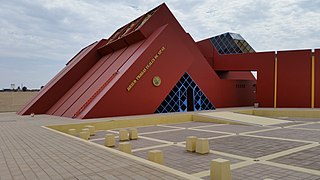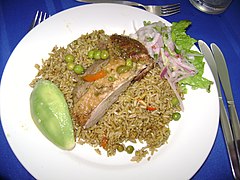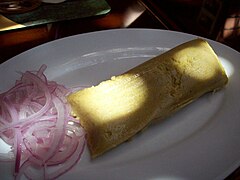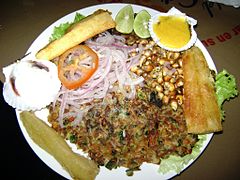Lambayeque Department
Lambayeque is one of the twenty-four departments that together with the Constitutional Province of Callao form the Republic of Peru. Its capital and most populated city is Chiclayo, it is located in the northwest of the country, bordered to the north by Piura, to the east by Cajamarca, to the south by La Libertad, and to the west by the Pacific Ocean. With 14,231 km², it is the fourth smallest department after Moquegua and with 95.29 inhabitants/km², the third most densely populated, behind Lima and Callao. It was founded on January 7, 1872. It is politically divided into 3 provinces and 38 districts.
History
The uncertain origins of the civilization of the Lambayeques, admired for their gold work, date back to the legendary King Naylamp, who arrived by sea and decreed the worship of Yampallec. Perhaps the Lambayeque or Sicán culture appears when the Moche culture collapses due to the intrusion of a new social, ideological and stylistic concept called Wari. Centuries later they were incorporated into the Chimú kingdom, distinguished by their extraordinary hydraulic works such as the Raca Rumi canal, which linked Chongoyape with the coast. Finally, in struggles that spanned four decades, the Incas subdued the Chimús barely a century before the Spanish conquest.
For its part, the mountain area of Lambayeque would have been occupied by Quechua groups who maintained a close relationship with the coastal kingdoms based on the exchange of products from the coast (salt, chili peppers or cotton) in exchange for water from the ravines that are born in the mountains.
In the actions for the Independence of Peru, the hero Juan Manuel Iturregui distinguished himself. Peruvian sailors Elías Aguirre Romero and Diego Ferré fought in the "Huáscar" and they died in the Naval Combat of Angamos during the war with Chile.
The territory of Lambayeque was cut by order of the Revolutionary Government of the Armed Forces. chaired by the government of General E.P. Juan Velasco Alvarado, in the Olmos district ceding it to Piura, subtracting 1059 km² from Lambayeque. Already in 1996 the district of Olmos changed its configuration and the sub-region II Lambayeque, which in turn integrated the North Eastern Region of Marañón in a transversal line that divided Lambayeque from Piura. In the government of President Alejandro Toledo, the regions and how they were configured were eliminated and the departments scheme was returned and the demarcation made by General E.P. Juan Velasco Alvarado.
Viceregal Period
When Viceroy Toledo on December 22, 1574 reorganized the corregimientos de indios (or natives), which had been created by Governor Lope García de Castro in 1565, he ordered that the corregimientos of Cajamarca, Chicama and Chimo or Chiclayo, Piura and Paita, Santa, and Saña depended on the Spanish corregimiento of Trujillo and the corregimientos of Cajamarquilla, Los Pacllas, and Luya and Chillaos depended on Chachapoyas. All in the district of the Royal Audience of Lima. In 1611 Los Pacllas was annexed to Chachapoyas, in 1635 Chicamo or Cliclayo was annexed to Saña and in 1773 Luya, Chillaos and Lamas was annexed to Chachapoyas.
On March 24, 1614, the Bishopric of Trujillo was established with the corregimientos of: Trujillo, Cajamarca, Cliclayo, Piura and Paita, Saña, Cajamarquilla, Los Pacllas, Luya and Chillaos, and Jaén de Bracamoros. In 1759 the corregimiento of Huamachuco was formed from that of Cajamarca.
The corregimientos were abolished in 1784, by King Carlos III and replaced by the municipalities. With the territory of the Bishopric of Trujillo (except Jaén de Bracamoros) the Intendancy of Trujillo was created. The corregimientos happened to be parties of the intendancy.
The system of intendancies was established in the Viceroyalty of Peru by means of the royal order of August 5, 1783, being applied the Royal Ordinance of Intendants of January 28, 1782. The first intendant of Trujillo was Fernando de Saavedra, who he assumed office in 1784, appointed by the viceroy at the proposal of the inspector general Jorge Escobedo y Alarcón and approved by the king on January 24, 1785.
It was part of the Municipality of Trujillo that came to have nine parties that were Trujillo, Lambayeque, Piura, Cajamarca, Huamachuco, Chota, Moyobamba, Chachapoyas, Jaén and Maynas, this last party previously made up the departments of what is now known as (Department of San Martín, Ucayali, Loreto) being the Municipality of Trujillo the largest in the Viceroyalty of Peru, that is, almost all of northern Peru today; its first mayor was Fernando Saavedra from 1784 to 1791. After him, Vicente Gil de Taboada (1791-1805 and 1810-1820), Felice del Risco y Torres (provisional) (1805-1810) and the Marquéz de Torre Tagle would follow. (1820), who led the independence of the Intendancy.
Foundation
On January 7, 1872, President José Balta projected the creation of the department of Lambayeque by Supreme Decree of January 7, 1872. On December 1, 1874, during the government of Manuel Pardo y Lavalle, its creation was confirmed by the legal provision signed by Vice President Manuel Costas; Originally its provinces were Chiclayo and Lambayeque and its capital the city of Chiclayo, both provinces dismembered from the department of Trujillo. On February 17, 1951, by law No. 11590, the province of Ferreñafe was created, creating the province of Lambayeque.
Geography
Surface
The territory of the Department of Lambayeque is the second smallest in the Republic of Peru, after the Department of Tumbes. It is made up of a continental sector and an insular sector.
The surface of the continental sector measures 14,213.30 km² and is made up of the three provinces of the Region. Of these, 3,161.48 km² correspond to the Province of Chiclayo, 1,705.19 km² to the Province of Ferreñafe, and 9,346.63 km² to the Province of Lambayeque.
The surface area of the insular sector measures 18.00 km² and is made up of two islands: Islas Lobos de Afuera (2.36 km²) and Isla Lobos de Tierra (16.00 km²), which are part of the Province of Lambayeque.
The total area of the entire department of Lambayeque, adding both continental and insular sectors makes a total of 14,231.30 km².
Location
The department of Lambayeque is located on the northern coast of Peruvian territory, 765 kilometers from the capital of the republic (Lima).
- It borders to the north with the provinces of Sechura, Piura, Morropón and Huancabamba, of the department of Piura.
- It borders the east with the provinces of Jaén, Cutervo, Chota, Santa Cruz and San Miguel, of the department of Cajamarca.
- West is coastal with the Pacific Ocean.
- It borders south with the province of Chepén, of the department of La Libertad.
It has the following coordinates as endpoints:
| Extreme points and coordinates. | ||||
|---|---|---|---|---|
| Guidance | North | East | South | West |
| South latitude | 05°28'37" | 06°46'30" | 07°10'27" | 06°22'12" |
| Western length | 79°53'48" | 79°07'09" | 79°41'18" | 80°37'24" |
| Place | Point at the C° El Duque, close to the emerging Odas. The Salado and El Duque. | C° Colpayaco, between the CC.PPs. Central, Cedar, La Chapa and El Lloque. | Cherrepe tip on the coast over the Pacific Ocean. | Cape Verde on the Pacific Ocean coast. |
Relief
Approximately 9 tenths of the department correspond to the coastal and yunga region and the tenth to the Sierra (Cañaris and Incahuasi).
La Costa or Chala, ranges from zero meters to 500 m s. no. m.; It is made up of extensive alluvial plains, some furrowed by rivers and others covered with sand. These plains are much more extensive than that of the southern departments, they are interrupted by rocky hills without vegetation that can rise from 200 to 1000ms. no. m.
The mountain ranges of the department are located in the foothills of the western cordillera, and reach 3000 and 3500 m a.s.l. no. m.
- Abras: Tembladera (a) 3650 m. n. m.) in Ferreñafe; Quesería (a) 2550 m. n. m.) in Lambayeque; Escalera (a) 1600 m. n. m.) in Lambayeque...
Climatology
The climate is semitropical, with high atmospheric humidity and little rainfall on the south coast. The maximum temperature can be around 35 °C (between January and April) and the minimum is 15 °C (July-August). The average annual temperature of 22.5 °C.
In summer it fluctuates between a minimum of 20 °C and a maximum of 35 °C; when the weather is completely sunny and hot, which happens variably. In winter the minimum temperature is 15 °C and maximum 24 °C, with cloudy mornings until after noon. Typically as it moves away from the sea moving east to 500 m s. no. m. the temperature rises, feeling intense heat mainly at noon, as can be seen in Pucalá, Zaña, Chongoyape, Oyotún and Nueva Arica.
Hydrography
River waters cover more than 95% of the water used in agriculture, industry and domestic use. Groundwater is abundant but little used due to the high cost of drilling tube wells and the lack of crop planning.
The main rivers are:
- River Chancay: Known by the name of the river Lambayeque, it is the most important. Its approximate length is 250 km. Its waters depend on the 3 provincial capitals, more than 15 smaller towns, agricultural and medium-sized enterprises and small individual producers. It is born west of the Hualgayoc mining seat in the Mishis and Yanahuanca lagoons, at a height of 4000 m. n. m.. In its origins it is known as Quilcate River, which goes down to the west receiving other small tributaries, without thickening their waters due to the leaks, the same ones that appear kilometers below. As you join the Saman River, you already get the name of Chancay River, you continue to travel west and get the waters of the Cumbil River. At the height of Racarumi, there is a take of that name that captures its waters to take them to the Reservoir of Tinajones, same as again pouring the waters to its bed, miles down. In the Puntilla there is an engineering work that divides the waters into two parts, that of the river Reque or Eten, and that of Lambayeque (canal Desaguadero), of which through other gates the water is divided: for the Taymi Channel for the river Lambayeque.
- Rio La Leche: also called Motupe or Morrope. Born at the summits of Cañaris and Cachen more than 3000 m. n. m. it has a very irregular volume of water and usually does not reach the sea, except in times of abundant rains. In rainy and abundant periods of water this river floods the coastal villages and the seedlings causing immense damage. In the lower part they join the Motupe. It flows into the La Niña lagoon.
- Río Zaña: Born in the Department of Cajamarca, east of Niepos, in its displacement and descent to the west receives the waters of numerous streams, already on the coast gives its waters to the towns of Oyotún, Nueva Arica, Zaña, Mocupe and Lagunas. Its waters in certain times as in 1925 and 1983 have caused damage to Zaña and other coastal towns.
- To the north of the Department, in the district of Olmos, are the streams: Cascajal, San Cristobal, and Olmos, of very short route. They don't get to the sea except in years of rain.
Oceanography
The Grau Sea or Peruvian Pacific off the coast of the department of Lambayeque has its temperate waters with an average temperature of 19 °C. at 20 °C, due to water blooms that occur off the coast and are transported by the Humboldt Current. The Grau Sea or Peruvian Pacific, is very rich in species. The biomass is made up of small fish, such as anchovy, and medium or large fish such as scallops, mussels, snails, etc. There is also a great variety of guano birds on small islands (Lobos de Tierra and Lobos de Afuera) and some points along the coast.
Administrative division
The Department of Lambayeque is the jurisdiction of the Regional Government of Lambayeque and is based in the city of Chiclayo as it is the capital of the Department. It is headed by a Regional President (Head of Government) and a Regional Council, both of whom serve for a period of four years.
It is divided into three provinces: Chiclayo Province, Lambayeque Province and Ferreñafe Province.
| Provinces of the department of Lambayeque | ||||||||
|---|---|---|---|---|---|---|---|---|
| Ubigeo | Province | Population (2017) | Population (2020) | Capital | Districts | Area km2 | Creation | Altitude msnm |
| 1401 | Chiclayo | 799 675 | 862 709 | Chiclayo | 20 | 3 288.07 | 1835 | 34 |
| 1402 | Ferreñafe | 97 415 | 107 241 | Ferreñafe | 6 | 1 578.60 | 1951 | 42 |
| 1403 | Lambayeque | 300 170 | 340 835 | Lambayeque | 12 | 9 612.85 | 1872 | 20 |
Each province is civilly governed by a Provincial Municipality, headed by a mayor, elected by universal suffrage every four years, who directs provincial politics. Chiclayo known as The City of Friendship and is located in the north of the country. Its climate is temperate and dry. The city has 70% of the inhabitants of the department of Lambayeque, which is why it is considered one of the most populated in the country. Due to its location, it is the important center of various communication routes, in addition, the departments converge around it due to its commercial movement.
Demographics
According to the census of October 21, 2007, the department of Lambayeque has an estimated population of 1,112,868 inhabitants, of whom 541,944 are men and 570,924 women. Its population density is 80.1 hbt/km² and its annual growth rate is 0.9%. The urban population is equivalent to 79.5% while the rural population is 20.5% of the total.
Most populated cities
The following is a table with the main cities of the department of Lambayeque:
Most populated districts
| Post | Province | District | Pob. 2023 |
|---|---|---|---|
| 1.o | Chiclayo | Chiclayo | 297,123 |
| 2.° | Chiclayo | José Leonardo Ortiz | 169,503 |
| 3.° | Chiclayo | Victoria | 101.361 |
| 4.° | Lambayeque | Lambayeque | 85,413 |
| 5.° | Lambayeque | Mórrope | 58.993 |
| 6.° | Lambayeque | Olmos | 58.260 |
| 7. | Chiclayo | Pimentel | 52,971 |
| 8.° | Ferreñafe | Ferreñafe | 38,990 |
Authorities
Regionals
- 2019 - 2022
- Regional Governor: Anselmo Lozano Centurión, de Podemos por el Progreso del Perú.
- Regional Deputy Governor: Luis Alberto Díaz Bravo, from Podemos for the Advancement of Peru.
- Counsellors:
- Chiclayo:
- Antonio Gregory Sánchez Chacón (Alliance for Progress)
- Esar Aguilar Valdera (We Can For Peru's Progress)
- Manuel Ceferino Huacchillo Gonzáles (We can for the Advancement of Peru)
- Nicolás Enrique Vallejos Celis (We Can For Peru's Progress)
- Ferreñafe:
- Glender Núñez García (Alianza para el Progreso)
- José Nicanor Martín Carmona Salazar (Democratic Party We Are Peru)
- Williams Juniors Velázquez Bardales (We Can For Peru's Progress)
- Lambayeque:
- Gisella Elizabeth Fernández Muro (We can for Peru's Progress)
- Mónica Giuliana Toscanelli Rodríguez (Alianza para el Progreso)
- Óscar Luis Carpena Recoba (Alianza para el Progreso)
Religious
- Bishop of Chiclayo: Mons. Robert Prevost Martínez
Economy
The Department of Lambayeque has shown great dynamism in recent years, reaching economic growth figures of over 10% in 2007 and positioning its contribution to the national GDP at 3.44% due to the export boom suffered by the Peruvian north coast and the takeoff of its agro-industry, mining, and manufactured industry due to the significant increase in its exports. In addition, significant investments have been made in all areas, especially in infrastructure that is currently carrying out large mining projects, irrigation, highways, airports, ports, among others. During the last years different investments were also made in tourism and hotels that represent 31% of the total investments in the department amounting to 300 million dollars. Around 30% of the trade on the north coast is concentrated in Lambayeque. The main activity is agroindustry followed by mining and agriculture.
Transportation
- Maritime ports: Eten and Pimentel.
- International Airport: in Chiclayo, which in turn is the basis of the FAP José Quiñones González.
Education
In the Lambayeque Region, as in the rest of the country, the educational system is divided into three levels: initial education, primary education, and secondary education. Then comes higher education that can be university, technical, productive or technological. The literacy rate is 92.6%, the schooling rate is 85%, and educational attainment is 90.1%.
Basic education
To provide basic education, the region has 1,561 educational centers (public and private). Of these, 426 are from initial education, 852 from primary education and 283 from secondary education.
Higher Education
For higher education, the region is home to the following universities:
- Universidad Particular de Chiclayo (UDCH).* Being one of the first universities in northern Peru.
- Universidad Nacional Pedro Ruiz Gallo (UNPRG).*
- Universidad San Martín de Porres (USMP).
- Universidad Señor de Sipán (USS).
- Universidad César Vallejo (UCV).
- Universidad Católica Santo Toribio de Mogrovejo (USAT).
- Technological University of Peru (UTP).
- Note: * Unlicensed
Culture
Moche or Mochica, Chimú, Sicán and Quechua culture.
Museums
In the region there are also the following archaeological museums:
- Royal Tomb Museum of Sipan
- Huaca Rajada-Sipán Site Museum
- Sicán National Museum
- Brüning National Archaeological Museum
- Tucume Site Museum
- Chotuna-Chornancap Site Museum
- Museum of Natural History Víctor Baca Aguinaga
- Museums of Lambayeque
Tourism
Lambayeque is not only archeological zones, beaches and museums. The Geographer and Naturalist D. López Mazzotti describes the dry forests of Laquipampa and Chongoyape, especially in the Chaparrí Private Reserve, the "waterfall" de Chongoyape and the immense lagoon created by the Tinajones Reservoir.
Gastronomy
Lambayecan gastronomy is the result of cultural miscegenation between its ancient pre-Hispanic cultures (Mochica, Sicán, Chimú) and the western world (mainly from Europe, Africa, China and Japan).
The ingredients in traditional Lambayeque cuisine are tubers (cassava, sweet potatoes, potatoes), cereals (corn, beans, limp beans); nightshades (panca, slime, monkey and cherry peppers); cucurbits (loche, squash); in addition to aromatic herbs (paico, molle, yerba buena, huacatay) and dyes (achiote and toothpick). To these are added kid meat, pork, poultry, fish and shellfish.
The most traditional dishes of Lambayeque cuisine are the seco de cabrito, the rice with duck, the thickened, the chinguirito, the humitas, the chirimpico, causa ferreñafana, fried chiclayano, the rice with seafood, the spicy chicken and the choros soup. The traditional desserts and sweets are king kong, alfajor, quince jelly, stuffed orange, alfeñique among others. Chicha de jora and yonque are the traditional drinks of the Lambayeque Region.
Regional symbols
The Lambayeque Region has a series of emblematic elements defined by regional decree. The Regional Flag, formed by two horizontal stripes of equal dimensions, gold, red, both colors being rescued from the Lambayeque Culture.
The Lambayeque Shield is divided into the point of honor and into three fields: the first represents honor and contemporary intellectuality, the second the wealth of the sea and power, the third natural resources represented by the carob tree.
The Lambayeque Region Anthem was written by Luis Rivas Rivas, with music by Rossana Díaz Torres and arrangements by Max Ucañay. The white-winged guan was declared a regional bird on March 3, 2005.
The logo of the Regional Government is the emblem of a regional character, it consists of a mythical figure represented in a golden copper crown of the Moche culture accompanied by the phrase "A Region with soul". It represents the values of work, strength, value, loyalty and honesty from Lambayeque, was declared by Regional Agreement in 2007.
Featured Lambayeques
The Lambayeque Region has been the cradle and home of notable and prominent people in different areas of science, arts, letters, among others. Many of them played an important role, not only in the history of the region but also of Peru and beyond its borders.
- Military: Juan Manuel Iturregui Aguilarte, Pascual Saco Oliveros, Baltazar Muro de Rojas, José Leonardo Ortiz Salcedo, Pedro Ruiz Gallo, Luis Gonzáles, Enrique López-Albújar Trint.
- Religious: Nicolas Ayllón.
- Marine: Juan Fanning García, Elías Aguirre Romero, Diego Ferré Sosa.
- Aviators: José Abelardo Quiñonez Gonzáles, Luis García Rojas.
- Literature: Enrique López Albújar, José Eufemio Lora y Lora, Juan José Lora, Yolanda Sánchez de Plenge, Augusto Castillo Muro Sime, Juan Mejía Baca, Alejandro Araujo Roman, Alfredo José Delgado Bravo, Alfonso Tello Marchena.
- Sculpture: Miguel Baca Rossi.
- Science and technology: Federico Villareal, Manuel Antonio Mesones Muro, Dr. Francisco Muro Pacheco, Dr. Francisco Muro Moreno, Federico Kauffmann Doig, Luis Chero Zurita, Carlos Wester La Torre, Klaus Hönninger.
- Education: Elvira García y García, Sara Bullón Lamadrid, Nicolás La Torre García, Karl Weiss Schreiber, Elvira Bulnes Torres, Eloy Arriola Senisse.
- Policy: Justo Modesto Figuerola de Estrada, Baltasar García Urrutia (Baltazar García Urrutia Muro), Germán Leguía y Martínez, Juan de Dios Lora y Cordero, Augusto Leguía, Alfredo Solf y Muro, Andrés Townsend Ezcurra, Genaro Barragán Muro, Miguel Ángel de la Flor, Luis Castañeda Lossio.
- Music: Ernesto López Mindreau, Luis Abelardo Núñez, Tania Libertad de Souza Zúñiga.
- Sport: Walter Vílchez, Óscar Vílchez, Hernán Castañeda Enrique Cassaretto.
- Cinema, radio and TV: Alejandro Borboy Echevarría, Mauricio Fernandini, Fernando Armas.
- Queens of beauty: Carmen Muro Távara (Miss Peru Mundo), Lucila Boggiano LacaWorld), Viviana Rivasplata (Miss Peru Mundo).
- Folclore: Manuel Expedito Muro Navarrete.
- Other: Vicente de la Vega, Almanzor Aguinaga Asenjo.
Contenido relacionado
Cabezabellosa de la Calzada
VI millennium BC c.
Parcel






















